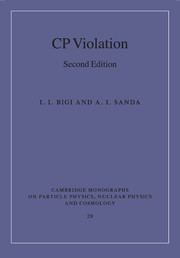Book contents
- Frontmatter
- Contents
- Preface to the second edition
- Preface to the first edition
- Part I Basics of CP violation
- Part II Theory and experiments
- Part III Looking beyond the Standard Model
- 16 Quest for CP violation in the neutrino sector
- 17 Possible corrections to the KM ansatz: right-handed currents and non-minimal Higgs dynamics
- 18 CP violation without non-perturbative dynamics – top quarks and charged leptons
- 19 SUSY-providing shelter for Higgs dynamics
- 20 Minimal flavour violation and extra dimensions
- 21 Baryogenesis in the universe
- Part IV Summary
- References
- Index
18 - CP violation without non-perturbative dynamics – top quarks and charged leptons
Published online by Cambridge University Press: 10 March 2010
- Frontmatter
- Contents
- Preface to the second edition
- Preface to the first edition
- Part I Basics of CP violation
- Part II Theory and experiments
- Part III Looking beyond the Standard Model
- 16 Quest for CP violation in the neutrino sector
- 17 Possible corrections to the KM ansatz: right-handed currents and non-minimal Higgs dynamics
- 18 CP violation without non-perturbative dynamics – top quarks and charged leptons
- 19 SUSY-providing shelter for Higgs dynamics
- 20 Minimal flavour violation and extra dimensions
- 21 Baryogenesis in the universe
- Part IV Summary
- References
- Index
Summary
The analysis of CP asymmetries in K and B decays – and likewise for charm – is clearly hampered by our failure to accurately evaluate hadronic matrix elements, since those are shaped by non-perturbative dynamics. There are, however, fermionic systems that are not subject to non-perturbative dynamics thus making our calculational tools more powerful. These are leptons – electrons, muons, τ leptons and neutrinos – and top quarks. The electron's EDM has been discussed in Section 3.6 and CP violation in neutrino oscillations in Section 16; the decays of charged leptons will be addressed here. As pointed out in Section 10.10.3 the aforementioned gain in calculational control comes with a price – namely at best small CP asymmetries. We will see that final state distributions rather than partial widths probably have the best chance to reveal CP violation.
Production and decay of top quarks
The existence of all members of three quark families has been established with the top quark being discovered last. Even before that time it had been realized that the top quark, once it becomes sufficiently massive, will decay (semi-)weakly – t → bW – before it can hadronize; i.e. top states decay as quarks rather than hadrons. This transition occurs around the 110–130 GeV region (for |V (tb)| ∼ 1), i.e. well below the mass value now observed. Non-perturbative dynamics thus plays hardly any role in top decays, and the strong forces can be treated perturbatively. While this is certainly good news for our ability to calculate observables, it carries also a negative message concerning the observability of CP asymmetries.
- Type
- Chapter
- Information
- CP Violation , pp. 396 - 411Publisher: Cambridge University PressPrint publication year: 2009



